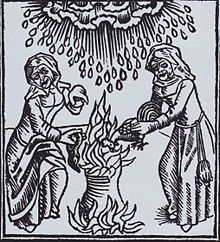Maria Grießer
Maria Grießer (also Maria Schneider, after her maiden name or her profession; * around 1640 probably in Bühl ; † December 19, 1682 near Lauchringen ) was a victim of the witch hunt and was executed.
course
On July 7, 1682, Maria Schneider, Jakob Grießer's wife, and her husband appeared at the office in Tiengen. There she complained about Thebus heuteuri and his wife Maria Oberlin von Riedern am Sand that they were calling her a witch for attacking and injuring her goat . The magistrate also heard the opposing party on this allegation, who insisted that Maria Grießer had been known as a witch for 20 years. Subsequently, other neighbors and residents of the village testified as witnesses against Maria Schneider. The files received deliver statements like milk spell , weather magic , other claims and alleged evidence. She was first interrogated on July 31st and denied everything. However, because they wanted to admit anything after repeated interrogation, they ordered under Article 45 of the embarrassment court order Emperor Charles V , the embarrassing questioning on.
Torture

On August 10th, the Sulzian councilors and senior officials issued an order to the Vogt von Dangstetten to call an executioner with a rack . Maria Grießer was first raised by the fingers, and 11 pounds of stones were hung on her feet. After an hour in which she did not confess despite the greatest pain, she was locked up again. Amicable questions still did not yield a confession, so she was tortured again on August 29, and again she did not admit anything.
On October 17th, she pleaded guilty after being tortured again. Shortly afterwards she revoked everything. She was then tortured again on October 21 with Spanish boots on her legs. She then pleaded guilty to all questions. On November 27th, she again retracted the testimony she had given under the torture.
Another torture was actually forbidden, but the trick was that the torture was merely "extended". The so-called third-degree torture was used, whereby the defendants' limbs were stretched on a ladder with pecked hares . When she was ready to confess again, the so-called conciliation , the confirmation of the confession in front of seven witnesses, could take place on December 1st .
judgment
On December 19, 1682 the judgment was made. The chairman of the Klettgau district court , the district judge and the town bailiff, a councilor on behalf of the landgrave, and a defender for the sake of form, were present. At her request, the sentence was softened to an execution with the sword instead of being burned directly.
enforcement
The sentence was carried out with great sympathy from the people. Later it was written on the cover of the trial files: Oh, terrible nonsense!
Aftermath
Three years later, on August 29, 1685, Magdalena Albrecht was executed in the same way by the same court. In her case, the sentence ended with the stereotypical sentence: "Everything in law and in equity."
literature
- Karl Friedrich Hoggenmüller: From the history of the community Lottstetten , community Lotstetten (ed.), 1981.
- Emil Müller-Ettikon: The witch of Bühl. In: Der Klettgau, Franz Schmidt (Ed.), Pp. 343 to 357 (very detailed), 1971
Individual evidence
- ^ E. Müller-Ettikon, Die Hexe von Bühl in: Der Klettgau, Franz Schmidt (ed.), P. 345
- ↑ Printed in E. Müller-Ettikon, Die Hexe von Bühl p. 355
- ^ E. Müller-Ettikon, Die Hexe von Bühl in: Der Klettgau, Franz Schmidt (ed.), P. 356
- ↑ Griesser from Klettgau
- ↑ Karl Friedrich Hoggenmüller, from the history of the community Lottstetten , 1981, p 137
| personal data | |
|---|---|
| SURNAME | Grießer, Maria |
| ALTERNATIVE NAMES | Schneider, Maria; Seamstress, Maria; Seamstress, Marie |
| BRIEF DESCRIPTION | Farmer's wife, wife |
| DATE OF BIRTH | 16th Century |
| PLACE OF BIRTH | Buhl |
| DATE OF DEATH | December 19, 1682 |
| Place of death | Leek rings |